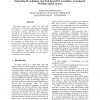499 search results - page 29 / 100 » Learning Through Telemedicine Networks |
IJCNN
2008
IEEE
14 years 2 months ago
2008
IEEE
— Spiking neural networks have been shown capable of simulating sigmoidal artificial neural networks providing promising evidence that they too are universal function approximat...
ESANN
2004
13 years 9 months ago
2004
Ensemble algorithms can improve the performance of a given learning algorithm through the combination of multiple base classifiers into an ensemble. In this paper, the idea of usin...
WMTE
2005
IEEE
14 years 1 months ago
2005
IEEE
The paper reports on a small pilot study that explores the role of mobile technology (m-technology) in English as second language (ESL) vocabulary learning for working adult learn...
SBRN
2000
IEEE
13 years 12 months ago
2000
IEEE
d Articles >> Table of Contents >> Abstract VI Brazilian Symposium on Neural Networks (SBRN'00) p. 24 Adaptation of Parameters of BP Algorithm Using Automata Hamid...
CEC
2009
IEEE
14 years 2 months ago
2009
IEEE
Abstract— In this paper we describe simulation of autonomous robots controlled by recurrent neural networks, which are evolved through indirect encoding using HyperNEAT algorithm...

